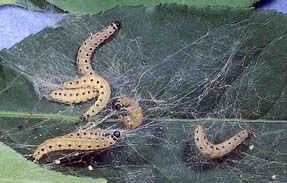Euonymus Webworm | |
|---|---|
| May 28, 2008 | |
|
html> Euonymus webworm, Yponomeuta cagnagella, feeds primarily on European and Japanese euonymus; and caterpillars have been found in northern Illinois. This insect is known in Illinois only in the northern portion of the state, being found as far south as Kankakee. Although it feeds on winged euonymus (burning bush) in Europe, it has not been reported feeding on that plant in Illinois.  Euonymus caterpillar larvae. Newly hatched caterpillars overwinter on the host and start to feed early in the spring. The larvae live as a colony, spinning silk webbing over a large number of leaves and feeding on the leaves within the webbing. As the leaves are consumed within the web, it is expanded to include more leaves. The larvae are slender caterpillars that are light yellow, with many black spots. Mature larvae are almost 1 inch long. Mature larvae pupate inside silk cocoons that hang vertically within the silk web, and they emerge as moths in June. The moths are white, with black spots on the wings. They have a 1-inch wingspan. After mating, female moths lay their eggs on the branches, twigs, and bud axils of the host. The eggs are covered with a gummy material that hardens, making the eggs difficult to see. Eggs hatch in August, and the hatchling caterpillar crawls under its eggshell to spend the rest of the summer, fall, and winter, emerging in the spring to feed. Euonymus webworm is controlled with a spray of Bacillus thuringiensis kurstaki (Dipel, Thuricide), spinosad (Conserve), pyrethroids, or other insecticide labeled for caterpillar control on trees and shrubs. The challenge is getting the insecticide to the larvae. The silk webbing that the larvae spin is water- and spray-resistant, requiring that enough pressure is needed to penetrate the web. With European euonymus being a large shrub to small tree, it is also practical to insert the spray gun into the webbing. Pulling or pruning off the caterpillar-containing webs and crushing the caterpillars is also effective. | |
| Author: | Morton Arboretum Phil Nixon |
